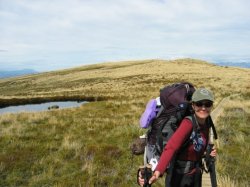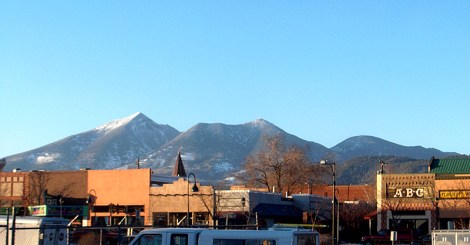
Nicole Woodman.
Nicole Woodman could have found an easier place to be a sustainability director — a place where left-leaning locals happily compost their kale stems and the mayor competes with other mayors to have the greenest city. A place like Minneapolis or Asheville, N.C. Instead, Woodman landed in Flagstaff, Ariz.
Her mountain boom town of 66,000, one of the gateways to Grand Canyon National Park, is facing water shortages so severe that officials are thinking of hauling water 40 miles uphill to supply the city during the dry season — that is, seven months out of the year. And while Flagstaff is home to a mosaic of different cultures, including college students, Native Americans, and second- or third-home owners, its roots in the conservative interior West are unmistakable.
“Some people say Flagstaff is so liberal and green,” Woodman says. “It is still Arizona.”
Things tend to heat up quicker in the Grand Canyon State. Take for instance state Republicans using fears of a supposed United Nations plot to ram through a law that would have effectively outlawed any environmental work. Or the fight Walmart waged in Flagstaff to overturn a city limitation on big-box store square footage. Walmart ran an ad comparing opponents to Nazis. Flagstaff has a new SuperCenter.
And the Flagstaff city council recently took a turn further right. One freshly elected councilmember notes in a blog that the city’s vision statement has been revised. “Sustainable” is no longer a word they use to describe their ideal Flagstaff. “You’ll notice some significant changes, a few significant words removed … I’m very pleased with the changes and Flagstaff’s new focus and direction,” he writes.
In the latest installment of Knope and change, our series about women leading the charge to make our cities more sustainable, I chatted with Woodman about Flagstaff’s water woes, a controversy surrounding a nearby ski area, and what it’s like to be in charge of sustainability planning in a place where the idea is, at times, not particularly popular.
Q. You started this job five years ago, before the national Tea Party movement took hold. How has your job changed since?
A. There have always been members on our city council that have taken the stance that the city shouldn’t be in “this business of sustainability.” It’s fortunate that we’re not general-funded, which tends to be quite common for sustainability programs. In 2006, the council passed the U.S. Mayors Climate Protection agreement. Staff at that time had the wherewithal to say, “If you’re going to do this, you need someone to lead the charge.” We have a very small budget and rely heavily on grants and a user fee on city water bills that funds a couple of programs, this one included. With the recent change in the council, we will sharpen our pencils a little bit more, but we’ve always had to be this way.
Q. Is your department safe under the new city leadership?
A. In theory, no one’s safe. We’re in public works. It would take a significant amount of effort for our funding source to be removed. You might call me in six months and they’re going after it, I don’t know, but we just brought in a $2.5 million grant and we’re going after a $5 million grant next year. I would like to believe it wouldn’t be a smart political choice [to shutter the department] but if someone wants to hang their hat on that, we’re up for [the fight]. We have a lot of friends in the community.
Q. What have you been able to accomplish so far, in terms of making Flagstaff a more sustainable city?
A. We just received a $2.5 million grant from Arizona state parks to help us acquire open space. If everything goes as planned, on Oct. 31, we will be purchasing our first large-scale open space for an educational and open-space research center.
We’re installing a little over 200 kilowatts of parking canopies in our city hall parking lot. Beyond the energy this is going to create — which is about 38 percent of what this facility needs — I’m excited that it’s right in downtown Flagstaff. If you come through Flagstaff, you hit old Route 66. We’re on a really important corner when people come into town to get to the Grand Canyon. It’s a really good showcase that we are taking our commitment seriously.
And we just celebrated 50 miles of our Flagstaff urban trails system two years ago. When it’s completed, it will be over 100 miles.
Q. Some people might say that Flagstaff, or really any city in Arizona, is fundamentally unsustainable because of the changing climate and water issues.
A. Yeah, you have a very good point. The Southwest is a very fragile ecosystem. Water is going to be the largest issue we face. We need to be prepared. If you ask me, we are behind the ball. We need to be having more serious and large-scale dialogue about water. Our most recent well we dug in Flagstaff was over 2,000 feet deep.
Q. Why aren’t people panicking?
A. We haven’t had any disasters related to water just yet, so the reality of [water shortage] doesn’t seem practical. Before I came on board, the city bought a ranch about 40 miles outside of town. The city is prepared — and there are still a lot of legalities and money that has to go into this — to get water seven months of the year from there. Imagine the energy it’s going to take to transfer water almost 40 miles uphill, with five booster stations, to a water treatment facility. You’re talking millions of kilowatt-hours. It’s a very divisive conversation in our community right now.
Q. What’s your solution?
A. At some point, lifestyles will change because of the water situation. Will it be in 20 years? Fifty? It’s hard telling. The city has never completed a water adequacy study on just how big our bucket of water is. We need to have a long-term approach.
Q. There’s been a controversy over the nearby San Francisco Peaks, where a ski resort plans to make snow from treated sewage effluent. How do you balance this type of reuse with local tribes, who say the plans would violate sacred grounds?
A. My program has not been involved in this dialogue at all. My understanding is that this started in early 2000 when the contract was approved by the city to sell reclaimed water to the ski resort during the winter. In the summer, the reclaimed water goes to city parks, soccer fields, and golf courses. It’s used in the community for recreational purposes. But we have extra reclaimed water in the winter — and the city would say that water is going to be coming from an A++ processing facility.
We’ve got a lot of industry in this community that’s based around recreational sports specifically tailored to seasons. There’s a strong part of the community that says, “If we don’t have the snow up there, the economic health of our community will be completely destroyed.”
But then we start talking about cultural issues and that’s a whole different dialogue. One of the things that felt like an oversight — and again, I wasn’t around but just looking back through things — the decision by the former city council to move forward on this request was strictly based on numbers. It wasn’t based on community and culture. When you make a decision in a vacuum, you tend to not hear everyone’s voices. That’s the unfortunate situation of how we are where we are today.

WikipediaDowntown Flagstaff and the San Francisco Peaks.
Q. How will climate change affect Flagstaff?
A. Flagstaff in the last few years has been a case study for it. [In 2010], we had catastrophic wildfires. As a result, we had flooding and a loss of life. [Ed’s note: The floods were caused by record-setting monsoon rains following the fires, which washed sediment from the scorched slopes and caused flash floods, one of which killed a 12-year-old girl.] And then we had extreme heat.
Government agencies are the first responders in those trying times. We need to prepare ourselves as government organizations to be able to better respond. It’s not something we can just check off a list. It will be years in the making. But we are having the dialogue.
Q. Best-case scenario, where do you see Flagstaff in 20 years?
A. I would like to see Flagstaff as not just an innovative community for Arizona but an innovative community in the West, on par with the cutting-edge things we see coming out of Portland or Boulder. I would love to see us pull together a strong identity and strong culture around resiliency, adaptation, and sustainability.
Q. I guess you probably don’t want to think about the worst-case scenario.
A. It will all be burnt to a crisp? No, I truly believe that there’s so much here and there’s so much potential that I can’t see us not tapping into it.



